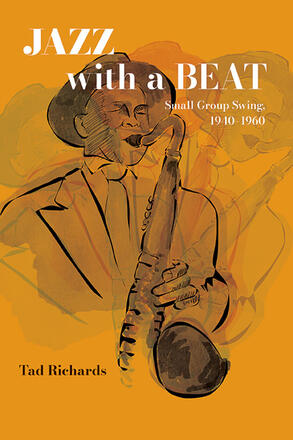
Jazz with a Beat
Small Group Swing, 1940–1960
Alternative formats available from:
The neglected small group swing sound of the 1940s–60s takes its place in the pantheon of jazz literature.
Description
Jazz with a Beat is the first book on the often overlooked but vitally important genre of small group swing jazz. Coming into being in the early 1940s, small group swing answered the need in the Black community for a form of jazz that was more accessible (and more danceable) than the new bebop. An adaptation of the big band Black swing (Erskine Hawkins, Jimmie Lunceford, Chick Webb) of the 1930s to small combos, and with a more vigorous beat for the new generation, this music developed and was beloved through the 1940s, continued to be enjoyed through the rock and roll years of the 1950s, and was a major influence on the soul jazz of the 1960s. Among the many hit artists portrayed in these pages are Illinois Jacquet, Louis Jordan, Big Jay McNeely, Joe Liggins, Nat "King" Cole, Red Prysock, Ruth Brown, Nellie Lutcher, Camille Howard, T-Bone Walker, and Ray Charles. Dismissed as "rhythm and blues," this music has been ignored by jazz historians. Jazz with a Beat honors this music as a legitimate genre of jazz and is a stirring evocation of an era. It should be of interest to lovers of jazz and Americana.
Tad Richards is a prolific visual artist, poet, novelist, and nonfiction writer who has been active for over four decades. He is the author (with Melvin B. Shestack) of The New Country Music Encyclopedia, among many books. He lives in Kingston, New York.
Reviews
"…Richards provides an exhaustively-researched but eminently readable look at this under-explored and under-appreciated flavor of small group/post-Big Band swing, and the new styles it would birth." — NYS Music
"…[an] interesting book … Richards has clearly put a lot of work into this. Several photos of the artists illustrate the text. Along with a general index and bibliography it has a substantial 15-page discography of all the records referred to. There is also a further discography by artist which lists recordings that can be obtained on CD, vinyl or digital streaming for those who want to hear more of this music." — Jazz Journal
"Tad Richards argues eloquently for the seminal role of the 'soul jazz' made by small combos that kept people dancing through the 1950s and became known as rhythm and blues. Richards has clearly done his homework and recounts the adventures of these lesser-known and enormously listenable players and their impact on the birth of rock 'n' roll in meticulous and lively style." — Chronogram
"Tad Richards handles his subject with taste, intelligence, and love. His conclusions are logical and well-researched. This is a good addition to your library of books on Black popular music of the period." — Billy Vera, American singer, songwriter, music historian, and leader of Billy Vera & the Beaters
"Jazz with a Beat shines a light on a music that was always a part of our consciousness, even if we didn't quite realize it, and gives us a whole new appreciation for it." — Michael Jahn, founding rock music columnist for the New York Times
"Writers and critics too often place music in style cubicles, partitioned off from the sounds around them. Only trouble is, artists rarely work that way. They have an open floor plan, and they mingle constantly. Tad Richards reaffirms that truth with a welcome dive into the under-explored and under-appreciated small swing combos and artists of the '40s and '50s, who made music from bebop to rhythm and blues. Richards finishes the book with a suggested soundtrack, which clinches his argument that if these artists are sometimes tough to categorize, they're always a pleasure to hear." — David Hinckley, former pop culture columnist, New York Daily News
"This is one of those books that we—jazz critics, jazz historians, jazz audiences, jazz musicians—have long needed. For a long time, these kinds of musical offshoots of jazz have been consigned by jazz people to mere footnotes in music history, but for the musicians who played this hybrid music called, in many cases, rhythm and blues, it was a living and it was life at a different, alternative, musical level. For audiences it was dance and fun and, later, nostalgia, a way of reliving the days when black popular music was a social thing in a much different way than 'modern' jazz was, for audiences of all colors and backgrounds. It is not that this kind of music has not been written about, but that few authors have had enough of a jazz background to fully understand the form and the context, as an offshoot of improvised music that was very rooted, not only in the black community, but in a concept of black entertainment that extended back to the early part of the twentieth century. It is well-researched and well-written, a rare book that shows both musical and social understanding and never sacrifices one for the other." — Allen Lowe, musician and author of Turn Me Loose White Man: Or: Appropriating Culture: How to Listen to American Music 1900–1960 and That Devilin’ Tune: A Jazz History, 1900–1950